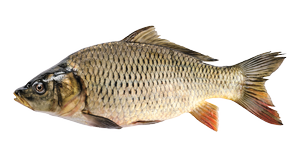
CARP
Carp are easily recognizable thanks to their rounded and powerful body shape, their grey-green color and the small barbels on the top lip and in the corners of the mouth. Carp are determined omnivores and originally come from Asia.
Fish facts
Common carp, mirror carp and leather carp are closely related. The carp you find at the fishmongers are farmed for eating.
Carps can be confused with the crucian carp, but these do not have barbels.
How to cook carp
Carp have a bad reputation in some cultures and are thought to taste muddy, but if they have been farmed in clean water, this isn’t necessarily true. The large number of bones is also a downside.
In Asia they have a trick to tackle this problem: You make deep cuts almost down to the backbone about a centimeter apart. When the fish is dipped into boiling oil – the most popular cooking method – the oil softens and melt the bones, improving the eating experience.
While some countries have no tradition of eating carp, in Eastern Europe and its original home in Asia, it is seen as a delicacy. The flesh is lean and palatable. It falls apart easily and the easiest cooking method is to cook the fish whole.
Carp taste good all year round.
Still sceptical? Get the full story on this blog: Can you eat carp?
The classic
Gefilte Fish, a Jewish favorite at festivals where no meat is eaten. The fish is stuffed with cooked vegetables and minced fish made from carp – may also include pike – and baked in the oven.
In Poland carp coated in flour and fried is a centerpiece on the table at Christmas.
Or marinated, with cuts down the sides, fried whole and served with fresh vegetables and strong piquant sweet-and-sour sauces like in Szechuan.








